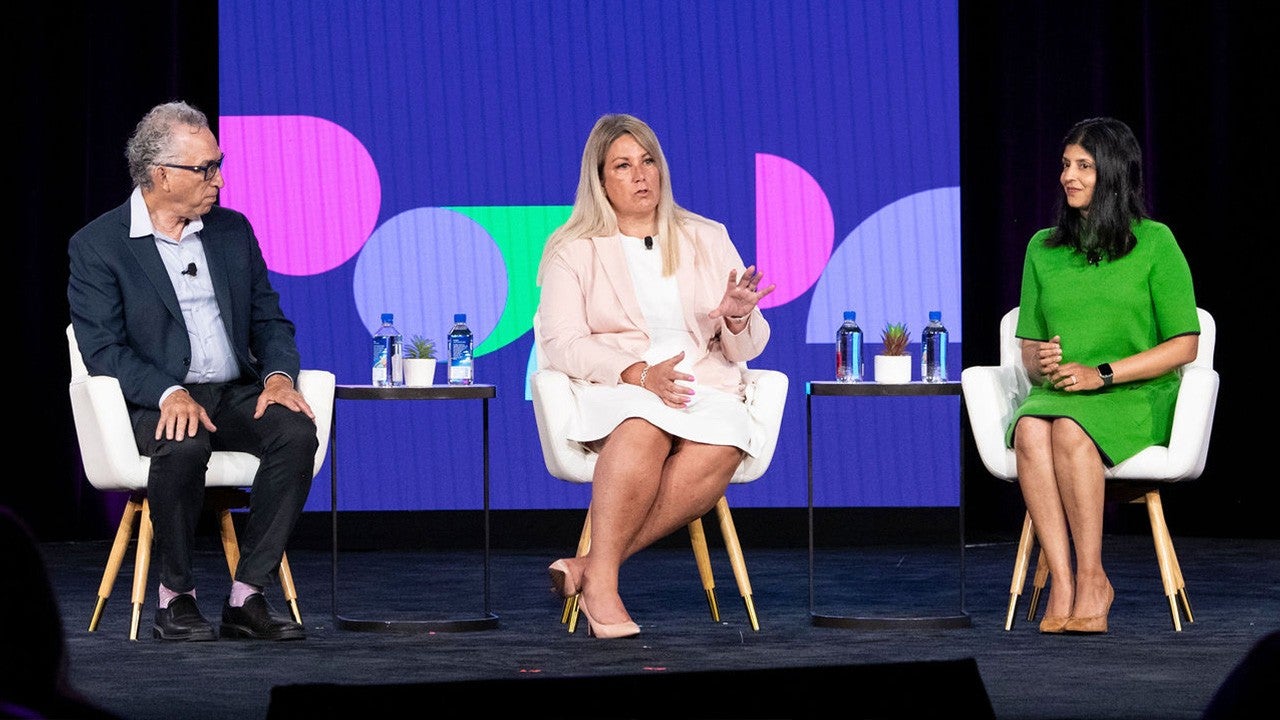

Building bridges to better health
David Ansell, MD, MPH, Senior Vice President for Community Health Equity, Rush University Medical Center
Gena Bugden, MD, Vice President of Medical Services and Chief of Staff, Newfoundland and Labrador Health Services
Saranya Loehrer, MD, MPH, Chief Health Equity Officer, Teladoc Health
Session: Bridge to Better Health: Closing Gaps in Care, Improving Access and Strengthening Communities
What does the rural community of the Canadian province Newfoundland and Labrador have in common with inner city Chicago? Both have agile health systems that are integrating technology and applying new and creative approaches to strengthen the health of their communities.
In the closing general session at Forum 2024, Saranya Loehrer, MD, Chief Health Equity Officer for Teladoc Health, led a discussion with Gena Bugden, MD, Vice President of Medical Services and Chief of Staff for Newfoundland and Labrador Health Services (NLHS), and David Ansell, MD, Senior Vice President of Community Health for Rush University Medical Center in Chicago, on how to better connect with communities to deliver equitable access, experiences and outcomes.
For NLHS, its primary challenge was delivering equitable care to a small population spread over a large geographical area. Dr. Bugden shared that telehealth has played a central role in connecting Newfoundland and Labrador’s 530,000 residents with care.
For more than a year, NLHS has partnered with Teladoc Health to offer primary care and virtual emergency room services. Since then, NLHS has served 8,000 clients through primary care and delivered 1,800 emergency room visits to patients, many of whom were not getting the care they needed before the implementation of the telehealth services.
“Some of these individuals would have to drive hours over very difficult conditions to reach the nearest emergency room. It is life-changing for these individuals to be able to receive care in their own communities and, sometimes, from their own home,” said Dr. Bugden.
The virtual care experiences have been well-received by patients and the community, with more than 95% of NLHS clients reporting the care and services were “exceptional” or “good.”
For Rush University, one of the highest-rated medical centers in the U.S., reaching the pinnacle of quality used to be the top goal. That was until 2016, when Dr. Ansell, who had just reached a decade of service as Rush’s chief medical officer, brought light to a more serious concern.
“We were trying to solve this problem of quality, but people are literally dying outside our doors of common diseases. If you live where we are now, you can live to be 85 or 90, but you go seven stops down the blue line, life expectancy plummets in that neighborhood to under 67.”
At that moment eight years ago, Rush University made an important change to its mission: eliminate the life expectancy gap in our communities.
To begin this important work, Dr. Ansell began looking at the root causes of the life expectancy gaps in local neighborhoods and realized social elements, including economic deprivation and structural racism, were the driving factors. That understanding led Dr. Ansell and Rush University to embrace their role as an anchor institution—organizations, such as medical centers, which have a unique opportunity to strengthen their local communities by employing community members, purchasing goods and services from local communities and investing in the neighborhoods.
Ultimately, they created West Side United, a partnership with Rush University and local leaders, employers, investors and small businesses, which focuses on improving the social and economic conditions that impact health. Dr. Ansell shared examples of successful initiatives, including moving their laundry linen services to a local neighborhood vendor, which created 200 jobs and saved Rush University $700,000 a year.
Leaders at West Side United and Rush University also observed that some of the underserved communities didn’t need additional clinics or hospitals—they needed access to technology that has been out of reach for these neighborhoods. To help close clinical gaps for people with high blood pressure and diabetes, they implemented remote monitoring technology to keep people on track with their health, and the results were positive.
“We went to a remote approach, understanding that getting on three trains or buses and coming into the office may not be ideal,” said Dr. Ansell.
“It turned out that a remote approach was not only cheaper, we got better outcomes with higher satisfaction, both for the doctors, but mostly for the patients. We also took a very complex group of patients and began to do home visits and remote monitoring in the homes, and it turns out it's better care.”
Both Dr. Bugden’s and Dr. Ansell’s initiatives are proving to be a success, but that success does not happen overnight or alone. “The community and its people are really engaged in how we can make this work,” said Dr. Bugden. “Similarly, our staff are also very engaged, and both of them together have been contributing to the success.”
Transformative leaders embracing change contributed to the success of Rush University’s efforts with West Side United. “What changed was our organization, from our board all the way down. And then when people saw the material impact of the work we were doing, it captured the hearts and minds of our employees and people,” said Dr. Ansell.
While success does take time, organizations can begin taking steps today that can have an impact tomorrow. Dr. Bugden encouraged the audience to consider the patient’s perspective and work to create a care pathway that they would want for themselves or a loved one. She also encouraged the audience to find a person in their organization who is a champion for change. Dr. Ansell added that it helps to start by solving a problem in front of you.









